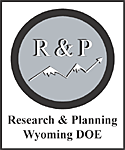Alternative Measures of Labor Underutilization Revisited
The unemployment rate released each month by the Research & Planning (R&P) section of the Wyoming Department of Employment represents one of several calculated by the U.S. Bureau of Labor Statistics (BLS).
The August 2009 issue of Wyoming Labor Force Trends included an article on alternative measures of labor underutilization (Cowan, 2009). At that time, the BLS started publishing those numbers by state on an annualized basis. Since then, the BLS has published the number quarterly, annualizing the numbers for the last four quarters of data available. The BLS publishes the alternative measures for states on a four-quarter basis in order to increase the reliability of the Current Population Survey (CPS) estimates, which are based on relatively small sample sizes at the state level, and to eliminate seasonality (U.S. Bureau of Labor Statistics, 2010).
The six measures of labor underutilization are defined as follows by the BLS (U.S Department of Labor):
- U-1, Persons unemployed 15 weeks or longer, as a percent of the civilian labor force;
- U-2, job losers and persons who completed temporary jobs, as a
 percent of the civilian labor force;
percent of the civilian labor force;
- U-3, total unemployed, as a percent of the civilian labor force (the definition of the official unemployment rate for the nation; see shaded area, Table 1);
- U-4, total unemployed plus discouraged workers, as a percent of the civilian labor force plus discouraged workers;
- U-5, total unemployed, plus discouraged workers, plus all other marginally attached workers, as a percent of the civilian labor force plus all marginally attached workers;
- U-6, total unemployed, plus all marginally attached workers, plus total employed part time for economic reasons, as a percent of the civilian labor force plus all marginally attached workers.
This article only compares Wyoming and surrounding states. Data for all states can be found at http://www.bls.gov/lau/stalt.htm.
Nebraska and South Dakota had the lowest overall U-1 through U-6 rates  for fourth quarter 2009 through third quarter 2010 (see Table 1). In contrast, Wyoming had the lowest alternative measures during 2008 (see Table 2). Utah had the largest percentage changes, though it did not have the highest U-1 through U-6 rates. With the exception of the U-1 rate, the highest rates were found in Idaho; Colorado had the highest U-1 rate of the seven states.During 2008, Colorado, Idaho, and Montana had the highest rates for U-1.
for fourth quarter 2009 through third quarter 2010 (see Table 1). In contrast, Wyoming had the lowest alternative measures during 2008 (see Table 2). Utah had the largest percentage changes, though it did not have the highest U-1 through U-6 rates. With the exception of the U-1 rate, the highest rates were found in Idaho; Colorado had the highest U-1 rate of the seven states.During 2008, Colorado, Idaho, and Montana had the highest rates for U-1.
Table 3 shows percentage point differences in alternative unemployment  measures from 2008 annual averages to fourth quarter 2009 through third quarter 2010 averages for Wyoming and surrounding states. Except for Colorado and Nebraska, the smallest percentage change was in U-1. In general the percentage point differences increased from U-1 to U-6. Nebraska and South Dakota had the smallest percentage increases in all six measures.
measures from 2008 annual averages to fourth quarter 2009 through third quarter 2010 averages for Wyoming and surrounding states. Except for Colorado and Nebraska, the smallest percentage change was in U-1. In general the percentage point differences increased from U-1 to U-6. Nebraska and South Dakota had the smallest percentage increases in all six measures.
The increase of the U-1 measure over the two time periods shows that the number of long-term unemployed is up. Large increases in the U-4 through U-6 rates indicate that there is a larger number of discouraged workers. In addition, the large increase in the U-6 rate also indicates that the number of involuntary part-time workers is rising.
These numbers show that besides rising unemployment in general, increased long-term unemployment and rising underemployment are issues that also need to be addressed by policy makers.
BLS Programs Supervisor Carola Cowan can be reached at (307) 473-3804 or ccowan@state.wy.us.
Cowan, C. (2009). Alternative measures of labor underutilization. Wyoming Labor Force Trends 46(8). Retrieved December 22, 2010, from http://doe.state.wy.us/LMI/0809/a2.htm
U.S. Bureau of Labor Statistics. (2010, October 29). Alternative Measures of Labor Underutilization for States, Fourth Quarter 2009 through Third Quarter of 2010 Averages. Retrieved October 29, 2010, from http://www.bls.gov/lau/stalt.htm
